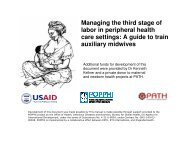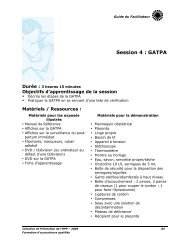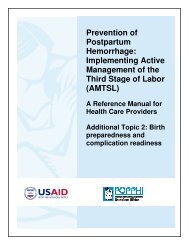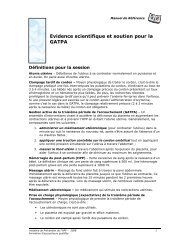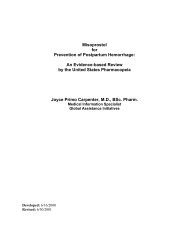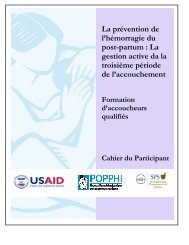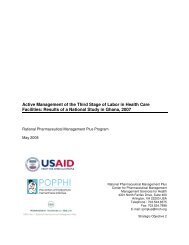Use of oxytocin and misoprostol for induction or ... - POPPHI
Use of oxytocin and misoprostol for induction or ... - POPPHI
Use of oxytocin and misoprostol for induction or ... - POPPHI
You also want an ePaper? Increase the reach of your titles
YUMPU automatically turns print PDFs into web optimized ePapers that Google loves.
Executive Summary<br />
The aim <strong>of</strong> this w<strong>or</strong>king paper was to compile in one place; definitions, recommended<br />
methods, rates, trends, indications <strong>and</strong> maternal <strong>and</strong> perinatal risks associated with<br />
<strong>induction</strong> <strong>and</strong> augmentation. The focus <strong>of</strong> this w<strong>or</strong>king paper is on <strong>induction</strong> <strong>and</strong><br />
augmentation in the developing w<strong>or</strong>ld, <strong>and</strong> the inclusion <strong>of</strong> data from developed<br />
countries was intended only <strong>f<strong>or</strong></strong> comparative purposes. The impetus <strong>f<strong>or</strong></strong> this w<strong>or</strong>king<br />
paper is the recent call <strong>f<strong>or</strong></strong> exp<strong>and</strong>ed availability <strong>of</strong> <strong>oxytocin</strong> <strong>and</strong> <strong>misoprostol</strong> to all<br />
maternity settings in developing countries <strong>f<strong>or</strong></strong> the purposes <strong>of</strong> active management <strong>of</strong> the<br />
third stage <strong>of</strong> lab<strong>or</strong> (AMTSL) to reduce postpartum hem<strong>or</strong>rhage, coupled with concerns<br />
that these drugs would then be widely available <strong>f<strong>or</strong></strong> <strong>induction</strong> <strong>and</strong> augmentation.<br />
The in<strong>f<strong>or</strong></strong>mation presented in this w<strong>or</strong>king paper comes from three sources: a<br />
compilation <strong>of</strong> international obstetric practice guidelines, analysis <strong>of</strong> <strong>induction</strong> <strong>and</strong><br />
augmentation rates from a seven country study on AMTSL, <strong>and</strong> a structured literature<br />
review which searched five electronic databases using broad search terms related to<br />
<strong>induction</strong> <strong>and</strong> augmentation. The w<strong>or</strong>king paper compiled data from 42 countries,<br />
representing all MDG regions, except <strong>f<strong>or</strong></strong> N<strong>or</strong>th Africa. Not surprisingly, few data are<br />
available from the private sect<strong>or</strong> <strong>or</strong> smaller health centers. The samples from three <strong>of</strong> the<br />
seven countries in the AMTSL study (all sub-Saharan African countries) did include<br />
health center data <strong>and</strong> suggest that <strong>induction</strong> <strong>and</strong> augmentation are being per<strong>f<strong>or</strong></strong>med in<br />
those facilities. Auth<strong>or</strong>s’ comments <strong>and</strong> references from some studies also suggest that<br />
<strong>induction</strong> <strong>and</strong> augmentation are being per<strong>f<strong>or</strong></strong>med at lower levels <strong>of</strong> the health system<br />
(without surgical capacity) <strong>and</strong> outside <strong>of</strong> the health system <strong>of</strong>ten putting maternal <strong>and</strong><br />
perinatal health at risk.<br />
In general, definitions, descriptions <strong>of</strong> the methods <strong>and</strong> indications <strong>f<strong>or</strong></strong> cervical ripening,<br />
<strong>induction</strong> <strong>and</strong> augmentation are consistent across obstetric practice guidelines from<br />
several countries <strong>and</strong> from guidelines <strong>and</strong> position papers from international agencies.<br />
Overall, data on <strong>induction</strong> <strong>and</strong> augmentation from developing countries are sparse <strong>and</strong><br />
there is a need <strong>f<strong>or</strong></strong> m<strong>or</strong>e research. National rates <strong>of</strong> <strong>induction</strong> <strong>and</strong> augmentation <strong>f<strong>or</strong></strong> all<br />
health facility-based births are not known <strong>f<strong>or</strong></strong> any developing country due to the lack <strong>of</strong><br />
1



